Today, we are making dehydrated seafood jambalaya. This recipe is really tasty, easy to make, and it rehydrates well. Sorry, we have no trailside cornbread, hushpuppies, or any other side dishes with this recipe.
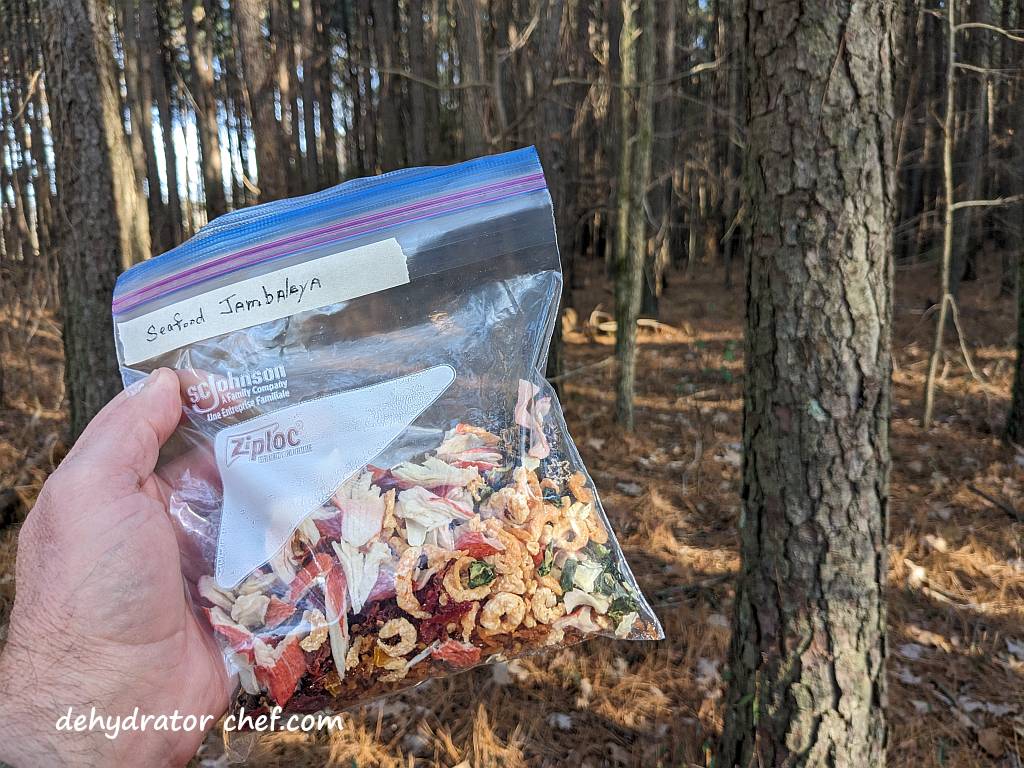
Using our Dehydrator Chef approach, we have dehydrated all of the ingredients in advance so we can build out our recipe. The ingredients have all been optimized to reconstitute in a reasonable period. So you’ll have a hot, satisfying meal in less than 30 minutes out in the field or at the campsite.
So, let’s get started.
Table of Contents
- Dehydrated Seafood Jambalaya Recipe
- Supplies and Tools needed for Dehydrated Seafood Jambalaya
- Dehydrated Seafood Jambalaya Dry Ingredients
- At-Home Preparation
- Optimize Food Protection for Storage and Travel
- In the Field Preparation
- Dehydrated Seafood Jambalaya Detailed Preparation Instructions
Dehydrated Seafood Jambalaya Recipe
Our dehydrated seafood jambalaya recipe only needs a handful of simple ingredients that you can easily dehydrate yourself. It tastes great and can be ready to eat in 30 minutes or less with our simple three-step process once you get to camp.
Supplies and Tools needed for Dehydrated Seafood Jambalaya
Supplies and tools to make our dehydrated seafood jambalaya are minimal, and nothing special or out of the ordinary is needed.
- Several 1-quart zip-top bags
- Heavy-duty paper towels
- Labeling materials such as masking tape and waterproof all-weather pen
- Camp cookware and dinnerware
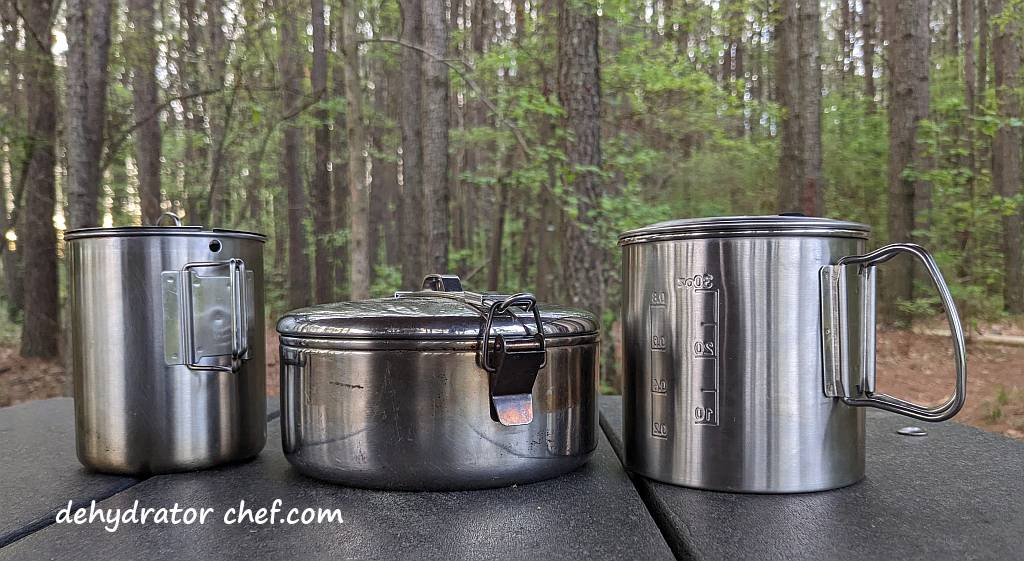
Look for lightweight, durable cookware compatible with your camping stove or heat source. Stainless steel or titanium cookware is popular for camping due to its durability and heat distribution ability. We prefer the 1.1-liter MSR Alpine Stowaway Pot; it’s a do-it-all workhorse.
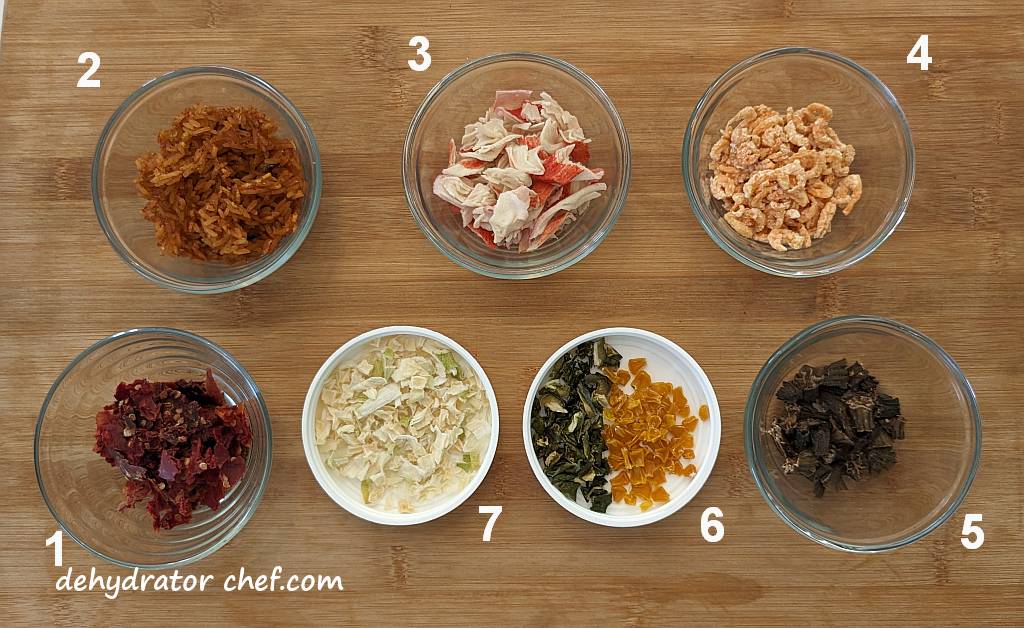
1) dehydrated RoTel diced tomatoes
2) dehydrated Zatarain’s Jambalaya Rice
3) dehydrated imitation crab
4) dehydrated shrimp
5) dehydrated cut okra
6) dehydrated green and yellow bell peppers
7) dehydrated onion
Dehydrated Seafood Jambalaya Dry Ingredients
This dehydrated seafood jambalaya recipe makes one serving approximately 140 grams of dry mix. Of course, you can adjust the ingredients as you wish.
- 45 grams dehydrated Zatarain’s Jambalaya Rice
- 20 grams dehydrated shrimp
- 30 grams dehydrated imitation crab meat
- 10 grams dehydrated RoTel diced tomatoes
- 3 grams dehydrated green bell pepper
- 3 grams dehydrated red or yellow bell pepper
- 5 grams dehydrated okra
- Salt and freshly ground black pepper to taste
- Olive oil or avocado oil (optional) in a leak-proof bottle
Dehydrated Seafood Jambalaya Ingredient Notes
We recommend making and trying this homemade dehydrated camping meal recipe several times at home before preparing it for the first time in the field so you will know what to expect. Armed with this experience, you can dial in the spices how you like and add or subtract any of the other ingredients. Don’t depend on untested gear or untested recipes.
We are omitting volume measurements as we update our recipes. Measuring dehydrated ingredients by weight makes for a more consistent product. The most accurate way to measure ingredients is by weight because minor differences in measuring can lead to substantial differences in the recipe’s outcome.
At-Home Preparation
Combine all the dry ingredients into a single food-safe 1-quart quality name-brand zip-top bag for the best storage results. The sharp edges of dehydrated ingredients may cause micro-punctures in lesser-quality zip-top plastic bags.

Label and date the zip-top bag to identify the contents. Masking tape and an all-weather pen with permanent ink work well here.
Compared to the local big box stores, Amazon has the best prices for the name-brand 1-quart zip-top bags. So says the 20,000 plus Amazon customer reviewers who took the time to leave feedback. The rough edges and sharp ends of dehydrated foods very often compromise generic zip-top bags. Quality zip-top bags are a necessity when making dehydrated meals for camping.
Be sure to include a short note with the name of the dish and detailed preparation instructions. We have included printable and detailed preparation instructions at the end of this page.
Optimize Food Protection for Storage and Travel
Double bagging, using two zip-top bags with a separator, is an option to help guard against punctures, leaks, and water penetration and to protect the food’s integrity. This way, it remains viable in the field or pantry storage.

The Scott Shop towels brand makes an excellent bag separator. These multipurpose paper towels are thicker than the average heavy-duty paper towel. As a multitasker, repurpose these towels for the after-meal cleanup activities.

The Scott Shop towels brand makes an excellent bag separator. These multipurpose paper towels are thicker than the average heavy-duty paper towel. As a multitasker, repurpose these towels for the after-meal cleanup activities. These towels have over 11,000 Amazon customer reviews with an average rating of 4.8 out of 5 stars, which is evidence of a great product. Check them out here. You might be able to find them at your local big-box megamart automotive department.
Be sure to include a short note with the name of the dish and detailed preparation instructions. This homemade dehydrated camping meal will look just like all others in your pack. We have included printable and detailed preparation instructions near the end of this page.
A bit of healthy cooking fat, such as olive or avocado oil added to the meal after cooking will significantly enhance the flavor. Fats concentrate the flavors in food. It gives the food a smooth and creamy texture that many of us crave. Since fat gives us more energy than proteins or carbohydrates, it makes us feel full faster, and it makes us feel content.
In the Field Preparation
Empty the contents of the zip-top bag into a suitable-sized cooking pot.
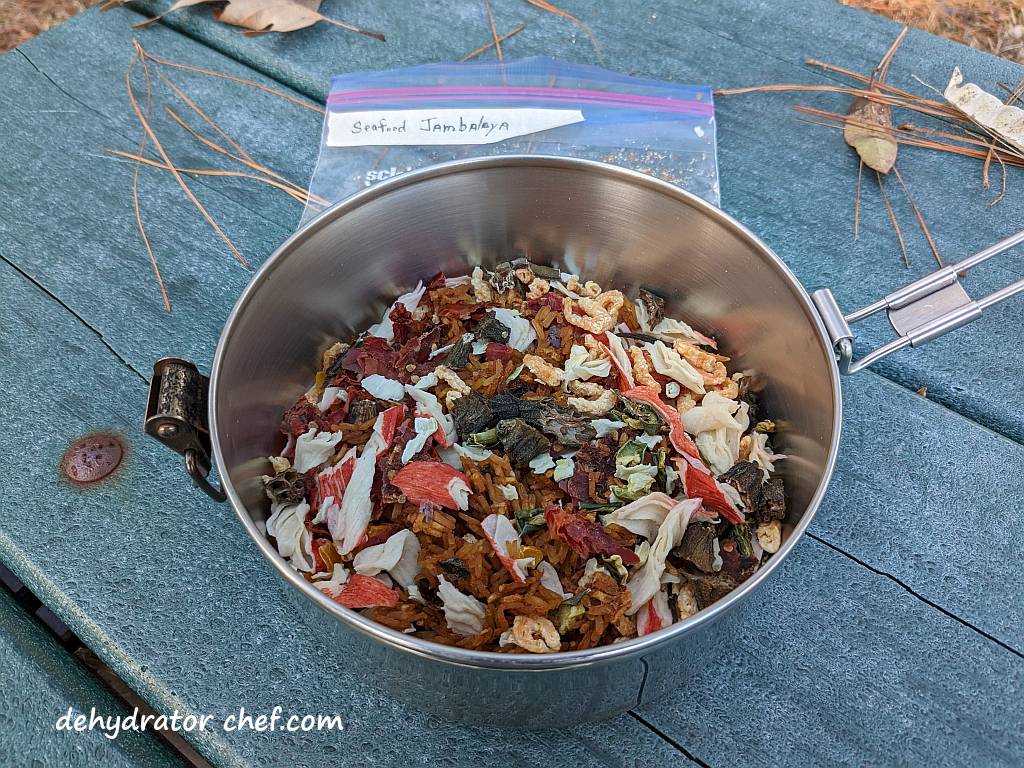
Measure in enough water to cover the dry ingredients. Then add a tad bit more water. Stir to mix thoroughly. Cover, and let the dry ingredients hydrate for a minimum of five minutes. Stir several times, and add more water if needed to keep all ingredients covered and well-saturated with water.
You’ll notice that the dry mix starts to soften and rehydrate in the water bath.

So why not add all the water at once? You certainly can, but we are metering in the water, so we don’t end up with a too-dry or a too-soupy product. Adding water in smaller amounts seems to work best for our Dehydrator Chef recipes.
One last thing: a little too much water is better than not enough water. Sure, dinner might be a little bit soupy; however, soupy is better than hard and crunchy. Lastly, soupy helps prevent burning. So, no worries here.
Next, on your cooking stove and over medium flame, bring the hydrating mix to a boil, frequently stirring frequently to mix. After coming to a boil, if your stove is capable of a low-heat simmer, turn the flame down to a simmer to reduce the chance of burning.
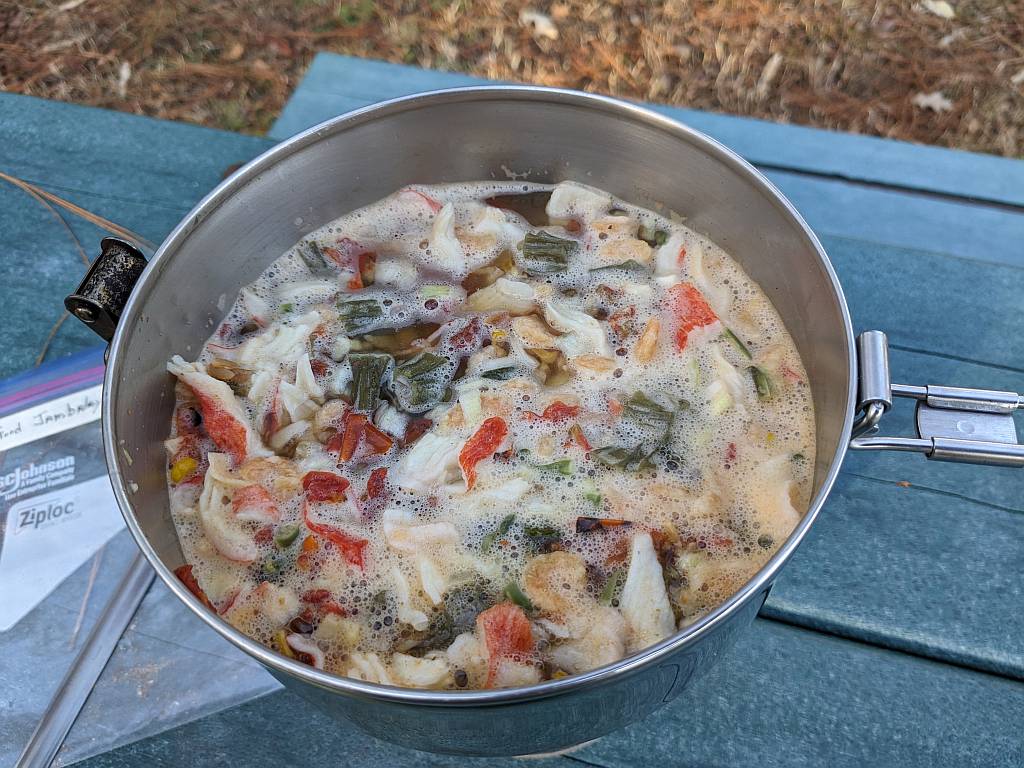
After two minutes or more of simmering, stirring, and mixing of the ingredients, turn off the stove and move the pot into an insulated wrap or cozy to rest and hydrate for at least 15 to 20 minutes more for the flavors to blend and the ingredients to fully reconstitute.
Practice these Dehydrator Chef homemade dehydrated camping meal recipes at home several times with the very same outdoor kitchen gear used in the field or at the campsite. This approach lets you practice your skills to know what to expect and where to adapt.
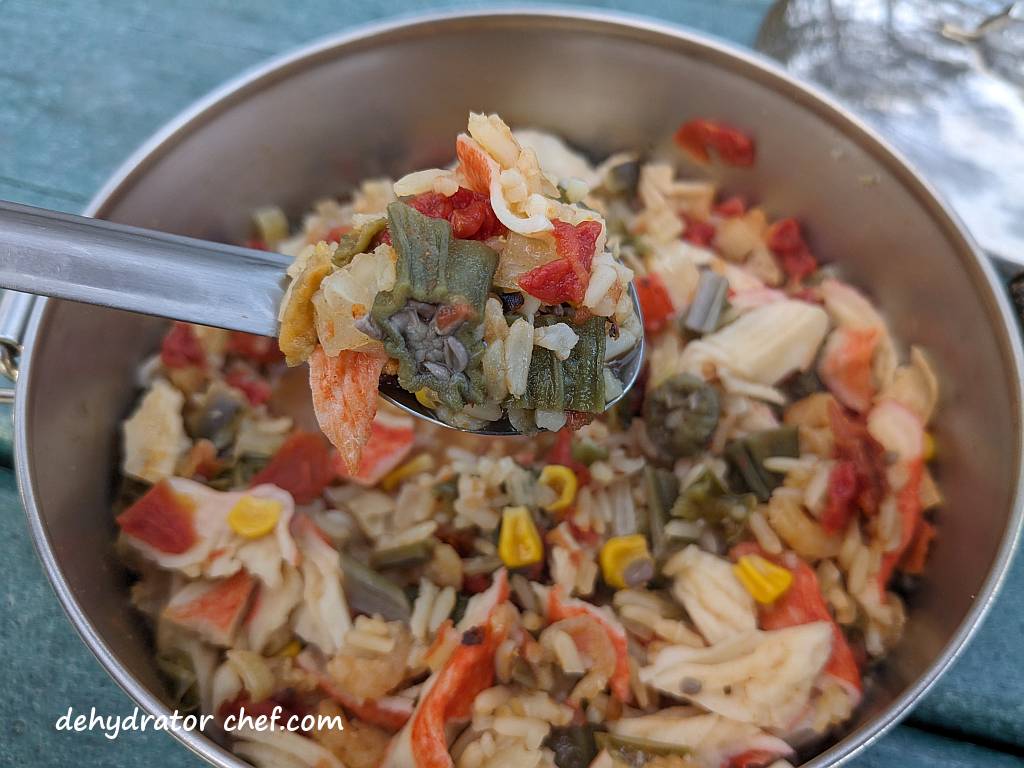
Dehydrated Seafood Jambalaya Detailed Preparation Instructions
Empty the dry mix contents of the zip-top bag into your cooking pot.
Pour in enough water to cover the dry mix, then add just a tad bit more.
Cover, and let the dry ingredients hydrate in your camp cookware for a minimum of 5 minutes. Stirring all of the way to the bottom of the cooking pot now and again. Make sure the mix stays covered and well-saturated with water. Add more water if needed.
Next, on your cooking stove and over a medium flame, bring the mix to a boil, stirring frequently, all the way to the bottom of the cooking pot. If your stove will simmer, turn the heat down after bringing it to a boil.
After two minutes of cooking, simmering, and ingredient mixing, turn off the stove and move the pot into an insulated wrap or cozy to rest and hydrate for 15 to 20 minutes more or until your preference for doneness.
